Since time immemorial, the Netherlands has been a sea-faring nation with a strong dependence on the sea. Traditionally, therefore, the Royal Netherlands Navy (RNLN) sailed throughout the world to safeguard Dutch interests. In the current security situation, the demand for naval assets for deployment in crisis management operations is even greater than ever before. ‘Gulf Defence Magazine’ offers you a glimpse of what sort of Navy the Netherlands will require and how that translates into specific ships, aircraft and submarines.
More than ninety percent of all countries border on the sea and sixty-five percent of the world population live within 300 kilometres of a coastline, and approx. 90 percent of all commercial traffic involves sea transport. The free use of the sea as a transportation route is, therefore, of great economic importance. Most crisis management operations will have a significant naval aspect, as result of the location of potential conflict areas and the dependence of many countries on the sea for their supplies and transportation. If the Dutch government decides to take part in international peace-enforcing or keeping operations, this means, for the RNLN, the possible deployment of frigates, Royal Netherlands Marine Corps (RNLMC) battalions or other units, such as minehunters, maritime patrol aircraft, a supply ship, submarines or a combination of these units. During the recent twenty years Dutch naval units, have already proved their value many times over in peacekeeping and humanitarian operations.
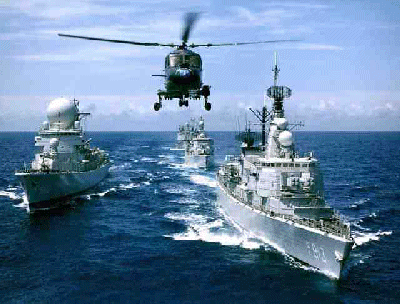
The RNLN operates not only on the water, but also above and below the surface. Linked together it forms a unit known as the task group. The operational concept of the RNLN is based on activities in these task groups. Dutch frigates are a permanent part of NATO’s squadrons in the Atlantic Ocean, named ‘Standing Naval Force Atlantic’ and in the Mediterranean Sea, named ‘Standing Naval Force Mediterranean’. While mine countermeasure vessels are permanently attached to the NATO flotilla named ‘Standing Naval Force Channel’. This fleet is responsible for monitoring and providing protection against mines for the benefit of all merchant shipping in North-Western European waters. NATO fleet alliances are geared to immediate intervention whenever necessary, both in and beyond the NATO treaty area. A close cooperation between the Dutch and Belgian navies has resulted in a joint operational staff since 1996, with its HQ, based in Den Helder. Apart from this, also the RNLN protects the territory and waters around the Netherlands Antilles and Aruba as part of the Netherlands Kingdom. There’s a permanent presence of a frigate and a marine battalion stationed in the Caribbean to fulfil these tasks. Also it has operational command of the Coastguard in the Netherlands and the Caribbean. Which duties include the tracing and rescue of people for drowning, enforcing shipping and maritime laws, fishery inspection, checking for violation of environmental regulations and combating illegal activities, such as drug trafficking.
RNLN frigate force: Today’s RNLN represents one of the most modern fleets in the world. With its frigate force as the workhorses and backbone of the fleet.
To be effective against an airborne threat, the defence against such is based on rapid response at long-range. This is assured by among other things: the ‘Standard Missile’ SM-1 MR Block IV, fired from an Mk 13 Mod 1 launcher and is a command guided, semi-active radar, capable of homing up to 46 km at the speed of Mach 2. Against short-range air-threats the NATO Sea Sparrow guided-missile system, loaded in the Mk 29 octuple launcher, which is a semi-active radar guided missile, capable of homing in up to 14.6 km at the speed of Mach 2.5 is being used. . Low-flying and highly manoeuvrable anti-ship missiles pose a great threat to ships, especially when several missiles are fired at once. For close-range defence it operates the ‘Goalkeeper’ rapid-fire gun system. With its 7 seven barrelled 30mm gatling gun it has the ability to unleash 4,200 shells a minute. The ammunition is made up of high velocity discarding sabot armor penetrators. Also it features improved software to improve their capability to engage dodging targets. It’s an autonomous and fully integrated weapon system for short-range defence against missiles and aircraft, with an effective range up to 2 km. The system automatically performs the entire process from surveillance and detection to destruction, including selection of the next priority target.
The near future replacement for the aging ‘De Ruyter’ (F 806), as the remaining Guided-Missile frigate of the ‘Tromp’ class (to decommission by 2003), as the new flagships of the RNLN, are the current under construction four Command & Air Defence Frigates (CADF) of the ‘Zeven Provinciën’ class. They will provide the RNLN major maritime Command & Anti Air Warfare contribution. Actually frigate is a misnomer: with a displacement of over 6,000 tons they are destroyers in all but name. When the first of the class enters service, it will arguably be the most advanced ship in it size in the world. These ships have extensive Stealth features designed into them. Survivability has been a great concern in designing the ships, and they are subdivided into seven main compartments. When hit in one of these compartments; ventilation, fire-control systems, and power will still be available in the other compartments. In order to achieve this all necessary systems have full-sized backups. For sensors the design features the APAR system, this is a high powered Active Phased Array Radar, which is smaller, yet considerably more powerful, than the American SPY-1 phased array radar. It can track up to 250 targets at one time, and at the same time can function as illumination radar for up to 16 targets (with 32 missiles in the air), removing the need for separate illumination radars. Because of its relatively small design it was possible to locate the four APAR panels in a single structure high above sea level. In a move which cause some last-minute delays the Dutch decided to have the APAR mount redesigned, so that in the future the guidance equipment for ‘Standard’ TBMD missiles can be fitted. The long range search radar is the SMART-L phased array 3D radar. This radar is not stabilized, but the emission-angle of the radar is adapted to the current sea state and angle. It has a range of up to 400 km, and can track up to 1000 targets. Mounted above the APAR, at the very top of the ship is a Sirius long range dual band infra red seeker, with a maximum range of roughly 30 km. Mounted on the hull is a Atlas Electronik active sonar. The first CADF, the ‘De Zeven Provinciën’ is expected to be fully operational at the beginning of 2002. The second one ‘De Ruyter’ should be active in late 2003. The ‘Tromp’ and ‘Evertsen’ should be in active service in 2004 and 2005 respectively. These new CADF ships are presented as the first line of naval defence against anti-ship missiles (diving, cruise, sea-skimming, supersonic) incoming at supersonic speed from any direction, highly maneuvering, in all weather conditions and in a severe electronic warfare environment, as well as aircraft attacks. The main tasks of these ships are to provide a local area air-defence capability against airborne targets for a task group, and to provide that same task group with varying levels of command embarked, and in a number of roles covering the full spectrum of activities from defence diplomacy, in peace and tension, to war.
Technical data on the ‘De Ruyter’ Guided-Missile frigate of the ‘Tromp’ class: Displacement: 4,308 tons full load. Dimensions: 138.2 x 14.8 x 6.6 meters. Propulsion: 2 shafts, 2 RM1A cruise gas turbines, 8,200 shp, speed 18 knots; 2 TM3B boost gas turbines, 44,000 shp, speed 30 knots. Crew: 306. Aviation: aft helicopter deck and hangar; 1 Sea Lynx helicopter. Radar: SPS-01 3-D air search. Sonar: CWE-610 hull mounted. Fire Control: WM-25 Sea Sparrow control, 2 x SPG-51C SM-1MR control, SEWACO-1 combat system. EW: Sphinx intercept, Ramses jammer, 4 SRBOC, SLQ-25 Nixie. Armament: 1 x Mk 13 missile launcher (40 SM-1MR), 4 x Harpoon SSM, 1 x 8-cell Sea Sparrow (16 missiles, manual reload), 1 dual 120mm/50 cal DP, 1 x 30 mm Goalkeeper CIWS, 2 x triple 12.75 inch torpedo tubes.
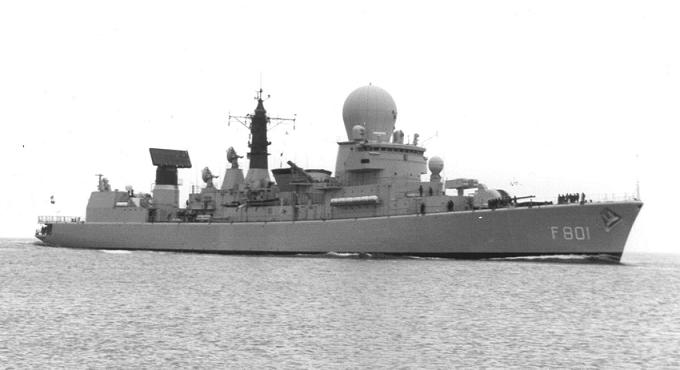
Technical data on the ‘Zeven Provinciën’ class command & air defence frigates: Displacement: 6,044 tons full load. Dimensions: 144.2 x 17.2 x 5.2 meters. Propulsion: 2 shafts, 2 cruise diesels; 2 Rolls-Royce SM-1C Spey gas turbines and speed is 28-30 knots. Crew: 202 (incl. flag). Aviation: deck and hangar for 2 NFH-90 helicopters. Radar: SMART-L and APAR. Sonar: Atlas-Werke hull mounted. Armament: 32 vertical launched SM-2MR, 32 vertical launched ESSM (Sea Sparrow), 8 Harpoon SSM, 1 x 5/54 DP, 2 x 30 mm Goalkeeper CIWS, 2 x 20 mm machineguns and 4 x 12.75 inch torpedo tubes.
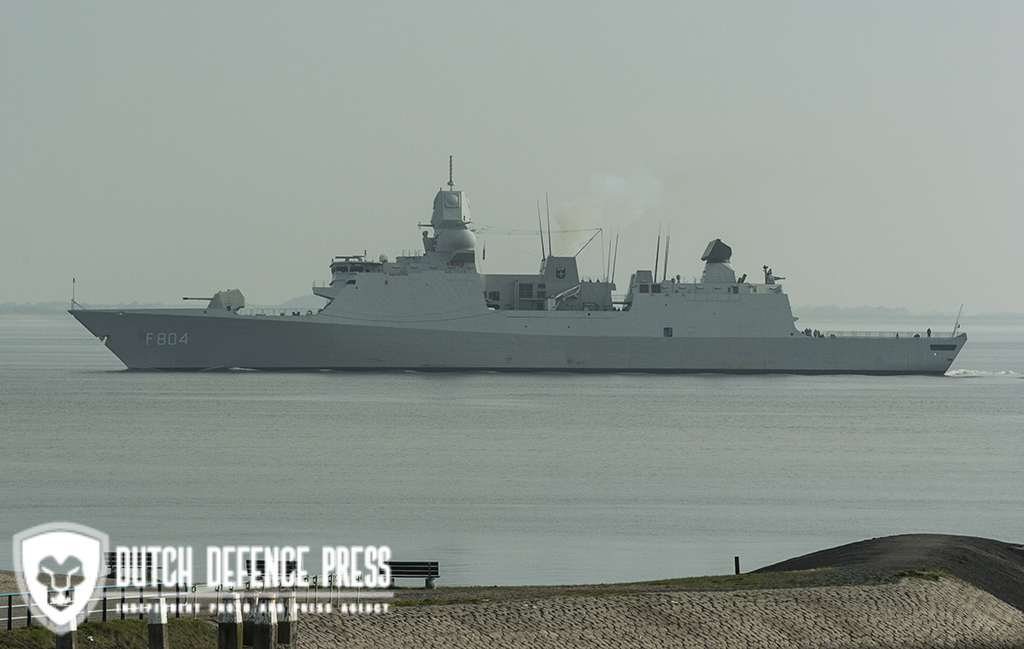
The second type of air-defence frigate in service are the two frigates of the ‘Jacob van Heemskerck’ class. In shape and appearance are these air-defence frigates practically similar to the Standard frigates of the ‘Kortenaer’ class but they lack the hangar deck and therefore also a helicopter on board. Also they don’t have the 76-mm/62 Oto-melara gun. Therefore instead its fitted with a Mk 13 Mod 1 launcher for the GDC Pomona Standard SM-1MR, Block IV Surface to Air Missile (SAM) on the back of the ship.
Technical data on the ‘Jacob Van Heemskerck’ class air-defence frigate: Displacement: 3,750 tons full load. Dimensions: 130.2 x 14.4 x 4.23 meters. Propulsion: 2 shafts, 2 RM1C cruise gas turbines, 9,800 shp to achieve a speed of 20 knots; 2 TM3B boost gas turbines, 51,600 shp, enabling a speed of 30 knots. Crew: 197 (plus 20 flag). Radar: LW-08 2-D air search, SMART-3D air/surface search. Sonar: SQS-509 hull mounted. Fire Control: 2 STIR-24 SM-1MR control, 1 STIR-18 Sea Sparrow control, SEWACO II combat system. EW: Sphinx intercept, Ramses active jammer, 2 SRBOC, SLQ-25 Nixie. Armament: 1 x Mk 13 missile launcher (40 SM-1MR), 8 Harpoon SSM, 1x 8-cell Sea Sparrow (24 missiles, manual reload), 1x 30 mm Goalkeeper CIWS, 4 x 12.75 inch torpedo tubes.
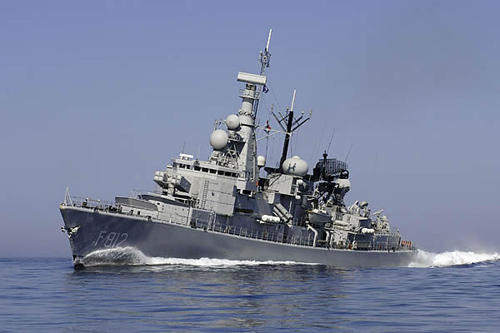
Built to replace two ‘Kortenaers’ Standard class frigates, sold to Greece prior to completion.
Anti-submarine and surface warfare type of frigates: In order to be able to track and neutralize submarines, it’s necessary for frigates, helicopters, submarines and patrol aircraft to cooperate very closely. Each of these weapon systems has it own specialisation. The following anti-submarine frigates detect subs with their sonar system and their also equipped with a Westland Lynx SH-14D (in the future it will be the NFH-90) helicopter with sonar. Both are fitted with the Honeywell Mk 46 Mod 5 anti-submarine, active/passive torpedo which is capable of homing in up to 11 km (5.9 n miles) at a speed of 40 knots with a warhead of 44 kg. The MK 46 torpedo is designed to attack high performance submarines, and is presently identified as the NATO standard. The helicopter is armed with two Mk 46 homing torpedoes and dipping sonar and has been upgraded with the FLIR Systems 2000HP FLIR (Forward Looking Infrared), GPS and radar altimeter. For the anti-surface role all frigates carries the Harpoon Block 1C missile, with a range of up to 100 km on board.
The third and final type of frigate in use are the eight Multi-purpose frigates of the ‘Karel Doorman’ class. The main gun of this type of frigate is the Oto-Melara 76 mm/62 compact 100 gun, this is the version with an improved rate of fire. It’s capable of firing 100 rds/min with an effective range of up to 16 km for anti-surface and 12 km for anti-aircraft defence. These ships are well suited to a variety of tasks and will be able to operate in the Atlantic as well as in the Channel and the North Sea. The shape chosen for the hull allows the frigates to maintain their speed even in high and rough sea. The improved rudder/roll stabilization system even allows helicopter operations in extreme circumstances. In order to mask their presence at sea they are equipped with a number of facilities, including low-noise output propellers, and a reduced radar signature. The M-frigates are equipped for anti-submarine and surface warfare. Its weapon systems are capable of simultaneously engaging multiple targets at varying ranges. These type of ships are also equipped with the Thomson marconi Sonar’s Anaconda DSBV 61 very low frequency passive towed array sonar mounted at the back of the ship. In the hull mounted sonar at the front of the ship, it’s equipped with the Signaal PHS-36 active search & attack medium frequency sonar system which has both FM and CW processing for underwater detection.
Technical data on the ‘Karel Doorman’ Multi-purpose class frigates: Displacement: 3,320 tons full load. Dimensions: 122.25 x 14.37 x 6.05 meters. Propulsion: 2 shafts, 2 cruise diesels, 8.540 shp, speed 21 knots; 2 SM1C boost gas turbines, 48.972 shp, speed 29 knots (F 827: SM1A, 37,540 shp). Crew: 154. Aviation: aft helicopter deck and hangar; 1 Sea Lynx helicopter. Radar: SMART 3-D air search, LW-08 2-D air search. Sonar: PHS-36 hull, DSBV-61A towed. Fire Control: 2 STIR-18 missile control, SEWACO VII combat system. EW: APECS-II/AR-700 active/passive, 2 SRBOC, SLQ-25 Nixie. Armament: 8 Harpoon SSM, 16 vertical launched Sea Sparrow, 1x 76 mm OTO DP, 1x 30 mm Goalkeeper CIWS, 2 x 20 mm Machineguns and, 4 x 12.75 inch torpedo tubes.
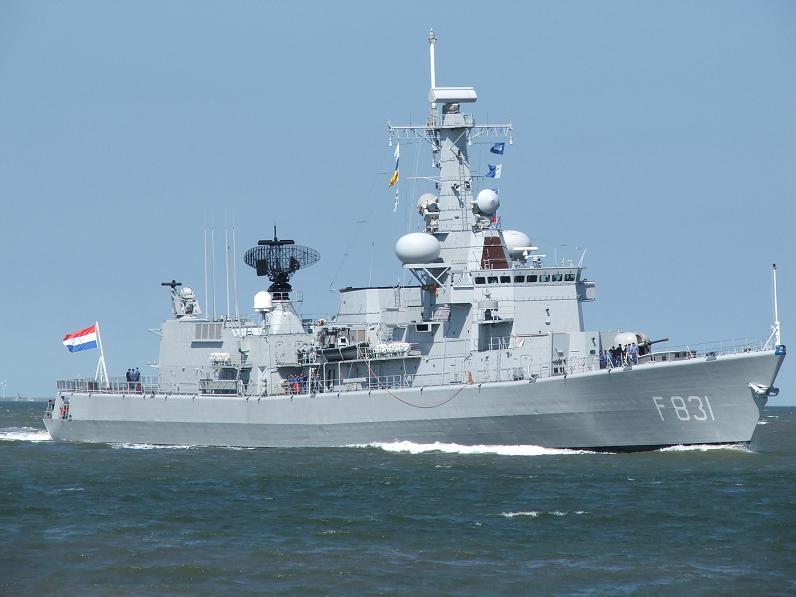
In high intensity operations, the frigates fleet specialist capabilities enable them to undertake key supporting and enabling roles such as defending high value ships in a task group and support forces ashore with artillery bombardment. In addition to these war-fighting roles, their comprehensive fits of highly capable surveillance and communications systems ideally suit them to a wide range of non war-fighting tasks. These include the policing of maritime boundaries between states, sanctions monitoring with associated maritime interdiction and boarding operations and offering reassurance and protection to Dutch, allied and neutral shipping. With afloat logistic support from the two Auxiliary Oiler Replenishmentships, the HNLMS ‘Amsterdam’ and the HNLMS ‘Zuiderkruis’ (often referred as floating supermarkets). RNLN frigates are able to operate worldwide and have sufficient sustainability to deploy away from base port for more than 6 months without recourse to host nation support. The RNLN frigate fleet contribute to nearly every task that the RNLN is required to perform. Versatile and powerful vessels they are multi purpose platforms, with embarked helicopters, delivering a broad range of utilities across the full spectrum of maritime operations, at all levels of intensity.
Technical data on the Auxiliaries & Replenishmentships:
‘Amsterdam’ multi-product replenishment ship: Displacement: 17,050 tons full load. Dimensions: 175 x 23.7 x 8 meters. Propulsion: 2 diesels, 2 shafts, speed 21 knots. Crew: 161 + 70 transients. Aviation: aft helicopter deck with hangar for 2 helicopters. Cargo: 10,300 tons. EW: intercept, 2 x SRBOC. Armament: 1 x 30 mm Goalkeeper CIWS, 2 x 20 mm guns.

‘Zuiderkruis’ multi-product replenishment ship: Displacement: 17,357 tons full load Dimensions: 169.59 x 20.3 x 8.4 meters. Propulsion: 2 diesels, 21,000 shp, 2 shafts, speed 21 knots. Crew: 173. Aviation: aft helicopter deck with hangar for 3 helicopters. Cargo: 9,000 tons fuel, 400 tons aviation fuel, 200 tons water, plus spares and munitions. EW: intercept, 4 x SRBOC. Armament: 1 x 30 mm Goalkeeper CIWS, 5 x 20 mm guns, 1 depth charge rack.
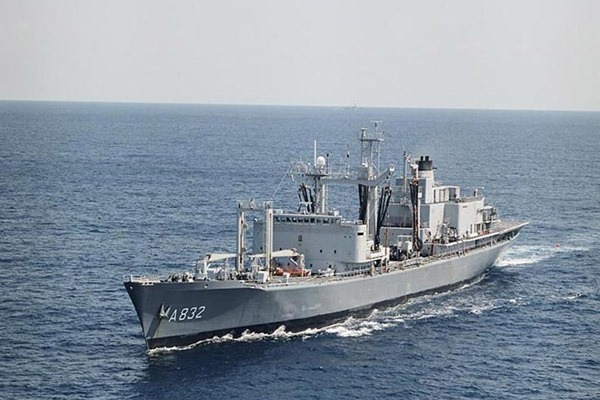
Royal Netherlands Marine Corps: Dutch naval strategy stresses the application of naval power at sea and, increasingly, projecting this power from the sea to directly influence events on land. Rapidly deployable amphibious forces are well placed to play an important part in this, especially when operating as part of an integrated joint and combined system. It’s a part of the RNLN that operates all over the world and whose operational area is where water meets land. The Corps motto, ‘Qua patet orbis’ (As far as the world extends) attests to this. The Corps provides a unique national capability with a worldwide, balanced and autonomous expeditionary capability. As part of NATO’s amphibious forces, the designated units of the RNLMC can be deployed immediately. The Corps is also called in for the protection of the territory of the Netherlands Antilles and Aruba and can be deployed for United Nations peace tasks. Within the RNLN, the Corps looks after the physical, military and ceremonial training of naval personnel.
There is also a Special Support Unit, which is deployed at the request of the Minister of Justice. The 1st Marine Battalion, the Amphibious Section (frogmen), the Boat Company (landing craft) and a 120 mm Mortar Company are integrated in the 3rd Commando Brigade of the British Marine Corps. Together they form the UK/NL Amphibious Landing Force. It can sail early and with orchestrated publicity or despatched without signal if political understatement is required. The force is not reliant on rights of access and does not need to infringe national territorial waters. It can poise at sea, raid or land on a potentially hostile shore at a place and time of choice and can sustain itself independent of shore infrastructure. It is equally suited to war-fighting or operations other than war and can conduct operations without re-supply for up to 30 days. Amphibious operations no longer means simply putting forces on to a beach. Dutch amphibious forces are based on specialist shipping and landing craft and can operate under the control of the mother ship several kilometres inland. Clearly troops on the ground require support. This is provided by integral elements of the RNLMC Operational Units Group in specialist areas such as HQ and signals, fire-support, logistics, recce troops, Special Forces, transport, medical, etc. The Landing Platform Dock (LPD), HNLMS ‘Rotterdam’, provide the backbone of this amphibious capability. In addition to this the order for a second landing ship will provide full amphibious capability, given their capability of carrying two battalion sized units, including their vehicles and heavy equipment whilst providing the vital command and control facility to embark an afloat Combined Joint Task Force headquarters. Once the second LPD by the year 2007 will enter service, the RNLN amphibious capability will be very impressive. Helicopters play a crucial role in providing this depth of assault, considerably widening the deployment options for the assaulting force. The ability to embark the recently procured NFH-90 Helicopters will also greatly increase this capability. In all, the RNLMC will consist of approx 3,500 personnel, which are highly trained, elite soldiers, they are able to operate in the frozen wastes of the Arctic or the jungles of the world.
Technical data on the ‘Rotterdam’ amphibious Landing Platform Dock: Displacement: 12,000 tons full load. Dimensions: 160 x 25 x 5.9 meters. Propulsion: Diesel-electric, 4 diesels, 2 shafts, 16,628 shp, speed 20 knots. Crew: 113-127. Aviation: aft helicopter deck with hangar; 4 x EH-101 or 6 x NFH-90 helicopters. Well Deck: 4 x LCU or 6 x LCVP. Troops: 600. Cargo: 170 armoured personnel carriers or 30 tanks. Radar: DA-05 air/surface search. Armament: 2 x 30 mm Goalkeeper CIWS, 4 x 20 mm guns.

Hydrography and oceanographic surveying is also a responsibility of the RNLN. The information from the surveys is used for producing Admiralty charts and nautical publications which have a world-wide sale and are used by ships of many nations. The surveying Flotilla consists of an ocean-going ship, the HNLMS Tydeman and an coastal vessel, the HNLMS Buyskes. Both these ships will be replaced by the year 2003 when two new 75 metres long vessels (the HNLMS ‘Snellius’ and the ‘Luymes’) enter service. These ships operational roles and principal operational tasks involve support to mine-countermeasures and amphibious operations, and the provision of Rapid Environmental Assessment (REA) to maritime component and joint forces. REA delivers tactical advantage to the commander, enabling him to exploit environmental conditions and minimise adverse effects. Routine tasks include military hydrographical, meteorological, oceanographic and geophysical data gathering in support of tailored products for submarine, surface and air operations and in collaborative programmes with Allies. Civilian research organisations may hire HNLMS Tydeman. In addition to surveying in overseas areas, ships of the flotilla are constantly engaged in updating the charts covering the waters around the Netherlands. To carry out these wide-ranging tasks the latest surveying techniques are employed, including digitised echo sounders, side scan sonar, automated plotting and recording of position, depth, gravity and magnetic parameters. Satellite and inertial navigation systems are used when out of range of shore-based position fixing systems.
Technical data on the ‘Tydeman’ survey/trials ship: Displacement: 3,000 tons full load. Dimensions: 90.15 x 14.43 x 4.75 meters. Propulsion: 3 diesels, diesel-electric, 2,730 shp, 1 shaft, speed 15 knots. Crew: 62 + 15 mission crew. Aviation: aft helicopter deck and hangar for 1 helicopter Sonar: hull mounted side-scan, towed side-scan, wreck location set. Employed mainly in mine countermeasures trials.
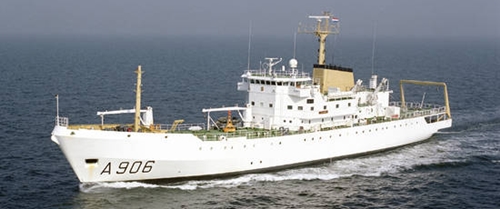
Technical data on the : Displacement: 1,025 tons full load. Dimensions: 58.80 x 11.13 x 3.7 meters. Propulsion: 2 diesels, diesel-electric, 1,100 shp, 1 shaft, speed 14 knots. Crew: 43. Sonar: hull mounted sidescan.
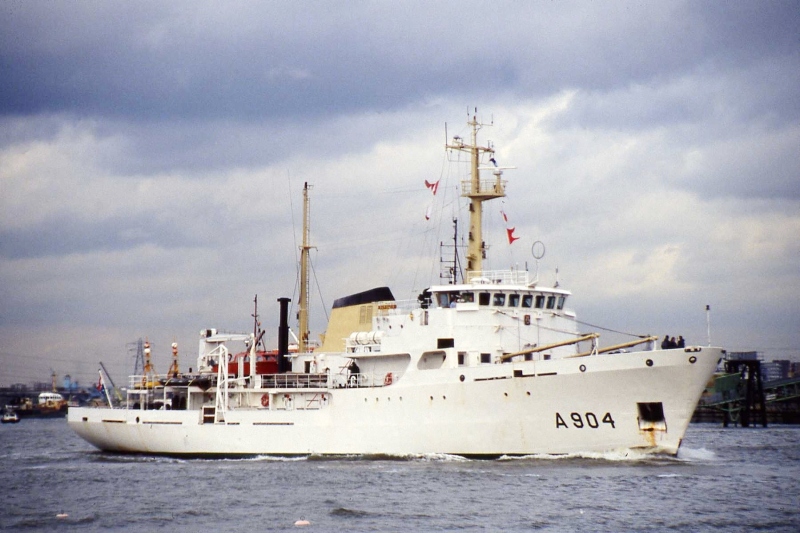
Mine Countermeasures (MCM): Maritime mines remain a serious threat to naval operations. Faced with the mine threat and its proliferation, the RNLN MCM capability exists as an enabling force to guarantee safe water for warships and merchant vessels. Mine Countermeasures is identified as a key capability for successful Joint Operations, particularly in littoral waters and for the projection of forces ashore. The MCM service is equipped with 15 mine-hunter/sweepers of the ‘Alkmaar’ class and 4 ‘Cerberus’ class diving auxiliaries. It has also diving and bomb disposal units, which are specialized in clearing mines and defusing other explosives, such as mines from the Second World War. The minehunters are divided into an operational flotilla and a work-up flotilla, with its home port in Den Helder.
Technical data on the ‘Alkmaar’ Tripartite class minehunters: Displacement: 540 tons full load. Dimensions: 51.6 x 8.96 x 2.6 meters. Propulsion: 1 diesel, 1,900 bph, 1 shaft, speed 15 knots. Crew: 34-42. Sonar: DUBM-21B minehunting. Armament: 1 x 20 mm gun. Multi-national project minehunters, seven ships will be modernized with new sonars and command systems; 4 of the 7 will receive a VDS to detect buried mines, and the other 3 will be modified as control ships for drone (Troika) mine countermeasures craft.
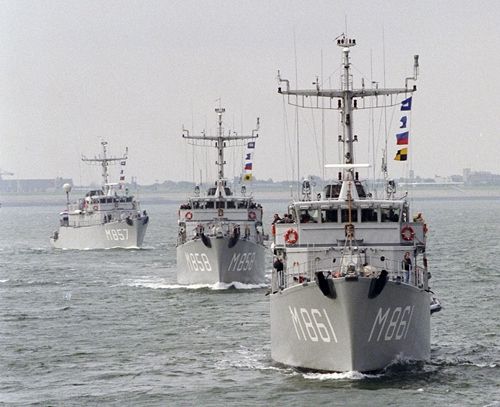
Submarines: Within the new concept of employment for maritime forces as a key part in wider joint operations, the submarine plays a crucial role. The Submarine Service comprises some 400 personnel and operates a flotilla of four ‘Walrus’ Class submarines. As early as the 1960s, a conscious choice was made for diesel-electric submarines rather than nuclear-powered vessels. The former can operate with lower noise levels and are thus eminently suitable for their tasks. A further advantage is that the construction and running costs of diesel-electric submarines are considerably lower than those of nuclear-propelled vessels. The new ‘Walrus’ class submarines contain state-of-the-art electronics, the most sophisticated weapon systems and an integrated Sensor, Weapon and Command system (SEWACO). Because of the highly advanced platform computerisation and integration of weapon systems, these boats can be regarded as a new generation . In the future, submarines can expect to be operating in advance of, and then as part of, a joint expeditionary force, often within a multinational context. In addition, the gathering of intelligence not obtainable from other platforms coupled with the ability to insert and recover Special Forces, makes the submarine a formidable and invaluable tool. Once other forces arrive in theatre submarines are able to integrate quickly, providing the task group with defence from both submarine and surface ship based attack, making it an extremely potent weapon. Another frequent peace-time task of the submarines is to act as target boats for frigates, maritime patrol aircraft and helicopters in order to keep the skills of these units up to scratch. Submarines travel to the deep waters of Scotland and Norway at regular intervals to adjust and set their torpedo launchers. On these occasions they are accompanied by the auxiliary ship HNLMS Mercuur. The crew of the ship retrieves the launched torpedoes from the water and prepares them for the next firing. The ship also acts as a target for the submarines. The home port of the submarines is Den Helder, but because of the close cooperation with the British navy they often operate from British ports.
Technical data on the ‘Walrus’ class submarines: Displacement: 2,800 tons submerged. Dimensions: 67.73 x 8.4 x 7 meters. Propulsion: 3 diesels, diesel-electric, 5.430 shp, 1 shaft, speed 21 knots. Crew: 50. Sonar: TSM 2272 active/passive, Type 2026 linear array. Fire Control: SEWACO VII combat system. Armament: 4 x 21 inch torpedo tubes (20 Mk 48 or NT-37 torpedoes, mines and Harpoon SSM). These boats will be given a midlife overhaul starting circa 2009.
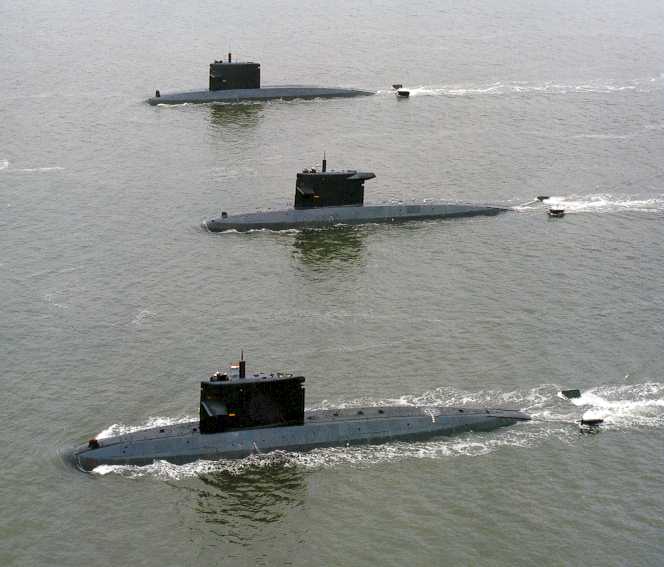
Technical data on the ‘Mercuur’ torpedo trials ship: Displacement: 1,500 tons full load. Dimensions: 212.5 x 38 x 14 feet. Propulsion: Diesel-electric, 2 shafts, 1,100 shp, speed 14 knots. Crew: 36 + 3 technicians. Armament: 2 x 12.7 mm MG, 2 x 21 inch torpedo tubes, 1 triple 12.75 inch torpedo tube.
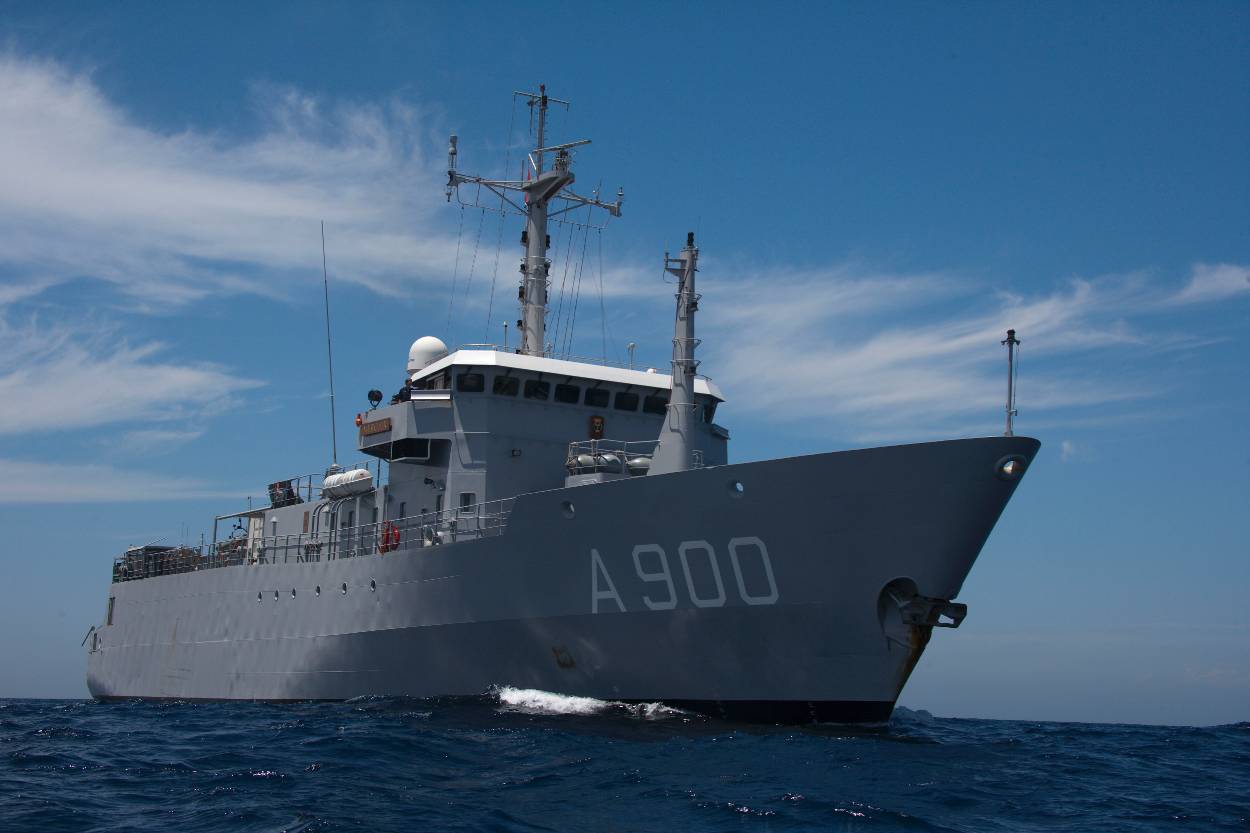
Fleet Air Arm: The success of following fleet movements, searching, locating and ‘in wartime’ eliminating enemy units is largely determined by the Fleet Air Arm. The Air Arm has two types of aircraft: long-range maritime patrol aircraft (MPA) of the Lockheed Orion P-3C-II type (13 in all) and Westland Lynx SH-14D helicopters (22 in all).
By exercising constantly at home and abroad, the crews prepare for their potential wartime task. The Orions always operate from a shore base, the Naval Air Station Valkenburg being their home base in the Netherlands.
The primary wartime task is to detect and destroy submarines. For this they are fitted with equipment to receive and process electronic emissions. They use radar and infra-red equipment to locate Subs on the surface and sonobuoys to detect submerged boats. The sensors and systems are fully computerized and linked to the screens in ships or other aircraft directly by radio. For the destruction of Subs the MPA carry homing torpedoes. Original plans call for a P-3 ‘Capability Upkeep Program’ that should involve the following items: replacement of the ASQ-114 central computer by the Paramax ASQ-212, installation of TI APS-137 ISAR, ALR-66 ESM and replacement of the ARR-72 acoustic processor by the CDC UYS-503. Other plans included universal display and control stations. In addition to its military taskings, the Fleet Air Arm also plays an important role in Search and Rescue (SAR) operations, which is coordinated by the coastguard organisation. covering large sections of the Dutch coastline, 24 hours a day and 365 days per year, typically at 15 minutes notice. Helicopters are constantly available and fly missions that are as varied as they are far-reaching.
Coastguard: The operational control of the Coastguard is the responsibility of the RNLN. It’s in full command of all Coastguard operations on and above the sea, in the Coastguard’s area of operation. In these duties, the Coastguard Center acts as the operational command center. The Coastguard’s tasks are as follows: monitoring, handling and coordinating national and international distress, emergency and safety radio traffic; coordinating and implementing relief and search and rescue operations; limiting and tackling the consequences of disasters and incidents; wherever necessary, implementing shipping guidance measures; maintaining law and order and providing assistance; monitoring measures aimed at limiting catches, and other technical measures applicable to sea fishing; monitoring compliance with shipping regulations; supervising ships equipment; enforcing environmental regulations; monitoring the import, export and transit of goods; preventing entry by undesirable aliens.
Conclusion: In the future, Dutch armed forces must be prepared to respond to a wide variety of threats and challenges from humanitarian operations to fighting conflicts. Such a capability should be capable of world wide deployment and should be joint and combined. New technology and systems integration mean that maritime forces will be increasingly capable of projecting power from the sea to the land within a joint and combined campaign. This gives the RNLN an important part to play particularly as maritime forces can influence all stages of a campaign. They can nip crises in the bud by threatening the use of force, conduct pre-conflict activities, take part in sustained operations and exploit opposition vulnerabilities from the sea flank.
In this new era, and the role of the RNLN in foreign and security policy, means that the size and shape of the fleet will continue to evolve. The driving factors are not simply those of need: the RNLN is very conscious of the requirement to operate within as a small a budget as possible, and to do so cost-effectively avoiding waste and unnecessary expense. This philosophy has been carried through into the design of the next generation of ships which have much smaller crews, a high degree of computer automation and are multi-role. They need to be multi-role to face the wide range of tasks that they will be called upon to perform around the world. But they must also be capable of carrying out specialist roles when needed. The potential and operational value of maritime power in today’s world is as relevant as it has ever been. They are mobile, versatile, resilient and can contribute sustained reach and lift capability to any campaign or operation. The ability to poise offshore also makes them powerful tools of diplomacy, which is of great importance in today’s world with any number of risks and uncertainties.
Success in modern warfare, however, depends on joint teamwork; battles are won by maritime, ground and air forces operating effectively together. In recognition of this, the RNLN has moved away from the Cold War focus on the north Atlantic, to being deployed on operations and exercises in every corner of the globe. Deployments vary in strength from single ships or submarines and/or amphibious task groups and, although they often take place away from the media spotlight, they are constantly at work defending the Netherlands Interests worldwide.



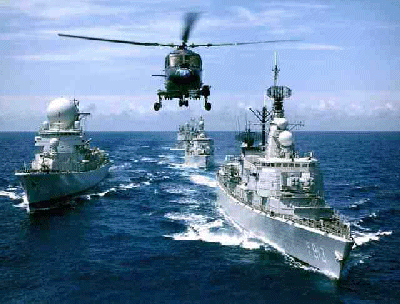

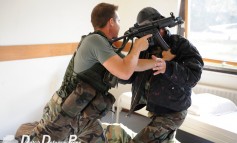
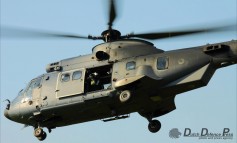
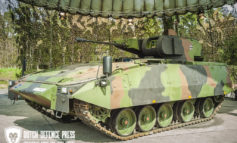
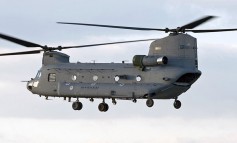



Leave a Reply